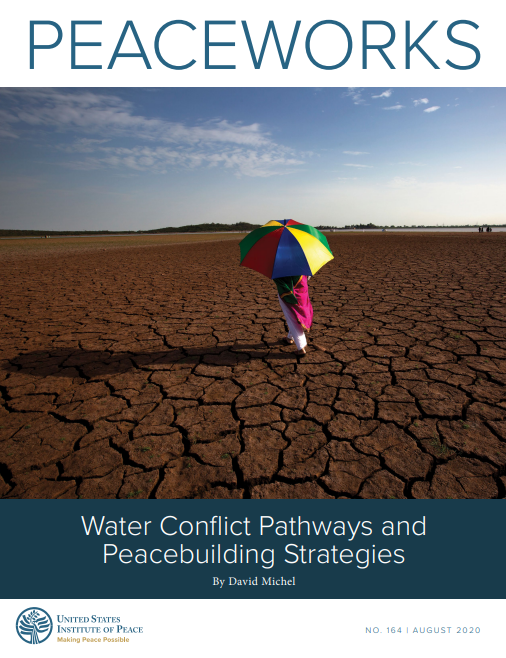The report emphasizes the link between water resource pressures and conflict risks, emphasizing the role of water diplomacy in risk mitigation. It underscores the importance of addressing indirect factors like political institutions, economic conditions, societal values, and perceptions to manage water insecurity. Effective water governance can enhance environmental and societal resilience, which is vital for future water resource management.
Highlights the strain on global freshwater resources due to rising populations, unsustainable practices, and environmental pressures, heightening conflict risk. Conflict triggers like infrastructure development, poor governance, and climate change impacts are prevalent. Thus, managing shared water resources cooperatively is vital to prevent conflicts and foster peace.
Overview
Water Insecurity and Conflict Risks
Begins by focusing on the escalating pressure on global freshwater resources caused by rising populations, unsustainable management practices, and environmental stressors. Although water wars are uncommon, it’s worth noting that the report indicates that water disputes can escalate to violent international conflicts and exacerbate civil unrest within countries.
Stresses that political institutions, economic conditions, and societal values impact water insecurity and conflict risks. It also underlines that conflict often arises from unfair water development distribution and inadequate decision-making access, not necessarily unequal resource distribution. Understanding the protagonists, causes, and contexts of different types of water conflicts can help identify early warning signs for potential risks. Furthermore, this understanding can assist in creating tailored strategies for conflict reduction and targeted peacebuilding.
Water Conflict Pathways
Examines potential connections between water resource strains and conflict risks. Discusses factors that can intensify tensions, like infrastructure development, weak governance, and climate change. Identifies conflict triggers such as reduced water supplies, increased demand, and severe flooding. Underscores the relationships between conflict actors and water resources, improving our understanding of water security threats. It emphasizes the potential for cooperation in managing shared water resources, aiding conflict prevention, promoting peaceful relations, and supporting peacebuilding in conflict-affected societies.
Case Study: The Indus River Basin
Accentuates the importance of the Indus River Basin, a central Asian water system. Stretching across Pakistan, India, China, and Afghanistan, it is home to approximately 276 million people. Furthermore, it supports a substantial economy of $380 billion. The Indus River Basin is vital for maintaining agricultural production, as most withdrawn water is directed towards this sector.
The Indus Basin irrigates most crops in Pakistan, where agriculture is a significant employment sector and contributes to the GDP. It’s also vital for growing food crops like rice and wheat in India, aiding food security. Additionally, it offers considerable hydropower potential, crucial in electricity-deprived areas. The case study underscores the Indus River Basin’s challenges, such as increasing water demand due to population and economic growth, environmental pressures, and excessive consumption. This has worsened water stress, increased yearly water withdrawals, and greater reliance on groundwater, constituting half of all basin withdrawals.
Case Study: Mali
Explores water scarcity in Mali, a land-locked West African country in the semi-arid Sahel region. With minimal rainfall, the northern half has sparse vegetation and limited agriculture. In contrast, the southern areas, which get more rainfall, support agriculture and the Niger River’s flow, aiding flood recession agriculture and irrigation. Points out how climate change and postcolonial government policies have disrupted traditional water and land access for pastoralist communities, particularly the Tuareg in the north.
As a direct result, these disruptions have contributed to long-standing conflicts between nomadic herders and sedentary farmers, leading to ongoing insurgencies and regional involvement. Mali is economically poor, with many rural inhabitants living in poverty. Access to drinking water is more prevalent in cities, intensifying water insecurity. The country’s unpredictable rainfall affects agriculture, causing economic losses and water-borne diseases.
The case study emphasizes the critical impact of water insecurity on Mali’s people and economy, suggesting it significantly lowers the GDP. It underlines the immediate necessity to handle water scarcity, promote sustainable water management, and enhance water resource accessibility. This approach will bolster livelihoods and reduce conflicts over limited water resources in Mali.
Case Study: Myanmar
Highlights Myanmar’s abundant freshwater resources and their significant potential for hydroelectric power generation. The country’s rivers are estimated to have the capacity to generate around a substantial 100 gigawatts of hydropower, thus presenting remarkable opportunities for economic development and energy production.
Myanmar began a critical political transition in 2011 after years of military rule, leading to crucial reforms to draw foreign investment and boost the private sector. They focused on using natural resources for economic growth. However, disputed use of water resources in areas claimed by different ethnic groups challenges sustainable development and political stability.
The case study emphasizes Myanmar’s concerted efforts to develop its water resources. Twenty-nine hydro stations contribute to 58% of the nation’s total power generation. Despite these marked advancements, issues persist with the equitable distribution of benefits from water projects, environmental impacts, and conflicts over resource ownership.
Finally, it underscores the critical need for inclusive governance mechanisms, stakeholder engagement, and conflict-sensitive approaches. These strategies are deemed necessary to address water-related challenges effectively, promote peacebuilding, and ensure the equitable and sustainable use of water resources for all communities in Myanmar.
Water Governance and Water Diplomacy
Emphasizes the importance of governance and diplomacy in managing shared water resources and preventing related conflicts. It highlights the need for collaboration, cross-border cooperation, and conflict resolution to address water challenges and foster peace in tension-prone areas. Water governance, crucial for sustainable management, fair access, and ecosystem preservation, involves managing water resources through specific processes, institutions, and regulations.
It is vital in resolving water conflicts, improving water security, and promoting cooperation among states with shared water bodies. Water diplomacy, involving negotiations to resolve water disputes and build trust among nations sharing water resources, is crucial in conflict prevention, promoting cooperation, and sustainable management of transboundary water bodies.
Peacebuilding Strategies for Water Resources Conflicts
Discusses water diplomacy’s role in promoting integrated governance, collaboration, and peaceful dispute resolution. It emphasizes the vital role of third-party involvement in fostering cooperation, streamlining processes, and providing resources for collective action in conflict-affected environments. Third-party water diplomacy is essential in managing conflicts, including communication, agenda setting, and facilitating dialogues.
These dialogues provide alternative channels, build confidence, and explore policies when formal negotiations fail. Hence, this diplomacy is crucial in facilitating dialogue, identifying issues, and working towards mutual solutions. The section highlights the role of inclusive governance, policy participation, and multi-stakeholder dialogue in mitigating water security risks and encouraging sustainable practices. It proposes strategies to improve knowledge resources, enhance data collection and sharing abilities, and incorporate scientific information into policy-making, which is essential for tackling water-related disasters and environmental pressures.
Therefore. Nonetheless. However. Nevertheless. In conclusion. Henceforth. On the other hand. Hence. Furthermore.




